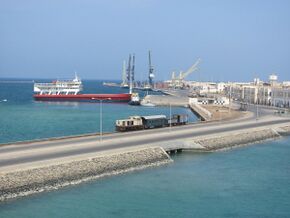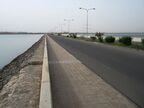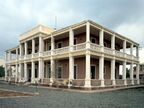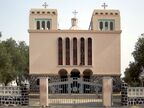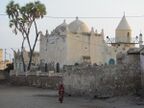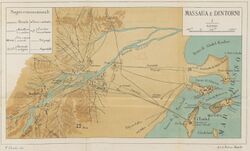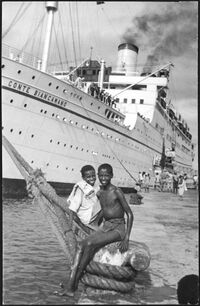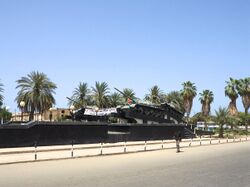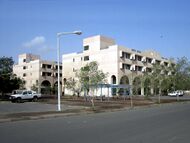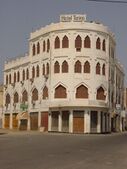Place:Massawa
Massawa Məṣṣəwaʿ (ምጽዋዕ) Mitsiwa | |
|---|---|
City | |
| Motto(s): Template:Lang-ti Pearl of the Red Sea | |
| Lua error in Module:Location_map at line 522: Unable to find the specified location map definition: "Module:Location map/data/Horn of Africa" does not exist. | |
| Coordinates: [ ⚑ ] 15°36′35″N 39°27′00″E / 15.60972°N 39.45°E | |
| Country | Eritrea |
| Region | Semienawi Keyih Bahri Region |
| District | Massawa |
| Government | |
| • Administrator | Kidane Weldesilase |
| Area | |
| • Total | 477 km2 (184 sq mi) |
| Elevation | 6 m (20 ft) |
| Population (2012)[1] | |
| • Total | 53,090 |
| • Density | 110/km2 (290/sq mi) |
| Time zone | UTC+3 (EAT) |
| Area code(s) | +291 4 |
| Climate | BWh |
Massawa or Mitsiwa (/məsˈɑːwə/ muh-SAH-wuh; Template:Lang-ti; Template:Lang-tig, Script error: The function "transl" does not exist. or ባድዕ, Script error: The function "transl" does not exist.; Ge'ez: ምጽዋ; Arabic: مَصَّوَع; Italian: Massaua; Portuguese: Maçuá) is a port city in the Northern Red Sea region of Eritrea, located on the Red Sea at the northern end of the Gulf of Zula beside the Dahlak Archipelago.[2] It has been a historically important port for many centuries. Massawa has been ruled or occupied by a succession of polities during its history, including the Kingdom of Aksum, the Ethiopian Empire, the Ottoman Empire and the Kingdom of Italy.
Massawa was the capital of the Italian Colony of Eritrea until the seat of the colonial government was moved to Asmara in 1897.[3]
Massawa has an average temperature of nearly 30 °C (86.0 °F), which is one of the highest experienced in the world, and is "one of the hottest marine coastal areas in the world."[4]
History
Massawa was originally a small seaside village, lying in lands coextensive with the Kingdom of Axum—also known as Kingdom of Zula in antiquity—and overshadowed by the nearby port of Adulis about 50 kilometres (31 mi) to the south. Massawa was known to Arab geographers from an early period. Ya'qubi referred to the Red Sea port in his Kitab al-Buldan as Badi, a corruption of its local Tigre name Base, while al-Masudi spoke of it in 935 as Nase.[5]
The city reputedly has the oldest mosque in Africa, that is the Mosque of the Companions. It was reportedly built by companions of Muhammad who escaped persecution by Meccans. Following the fall of Axum in the 8th century, the area around Massawa and the town itself fell under the occupation of the Umayyad Caliphate from 702 to 750 AD. The Beja people would also come to rule within Massawa during the Beja Kingdoms of Eritrea from the year 740 to the 14th century. At this time, the Sheikh Hanafi Mosque, one of the country's oldest mosques, was built on Massawa Island. Massawa was situated between the sultanates of Qata, Baqulin, and Dahlak.
In the early 14th century, the town then fell under the control of the Ethiopian Empire, Massawa was first mentioned in the war songs of Emperor Yeshaq I. In the mid 15th century Emperor Zara Yaqob of Abyssinia consolidated his rule in the region and incorporated Massawa into the Christian province of Midri-Bahri. During this time the port was frequented by Armenian and Venetian merchants.[6][7]
Portuguese influence
In the struggle for domination of the Red Sea the Portuguese succeeded in establishing a foothold in Massawa (Maçua) and Arkiko[8] in 1513 by Diogo Lopes de Albergaria, a port by which they entered the allied territory of Ethiopia in the fight against the Ottomans. King Manuel I first gave orders for the construction of a fortress that was never built. However, during Portuguese presence, it was lifted as well as the existing cisterns and wells for the Portuguese Navy watery.[9] It was drawn by D. João de Castro in 1541 in his "Roteiro do Mar Roxo"[10] in their route to attack El Tor and Suez. The captain of the Arkiko was the Portuguese Gonçalo Ferreira, second port on the coast that guaranteed the presence and maintenance of the Portuguese fleets, whenever the port of Massawa was threatened by the Turkish presence.[9] In 1541 the Adalites ambushed the Portuguese at the Battle of Massawa.[11]

Ottoman rule
Massawa rose to prominence when it was captured by the Ottoman Empire in 1557. The Ottomans tried to make it the capital of Habesh Eyalet. Under Özdemir Pasha, Ottoman troops then attempted to conquer the rest of Eritrea. Due to resistance as well as sudden and unexpected demands for more, the Ottomans did not conquer the rest of Eritrea. The Ottoman authorities then tried to place the city and its immediate hinterlands under the control of one of the aristocrats of the Bellou people, whom they wanted to appoint "Naib of Massawa" and almost made answerable to the Ottoman governor at Suakin.[12] The Ottomans nevertheless built parts of the old town of Massawa on Massawa Island into a prominent port on the Red Sea. These buildings and the old town of Massawa remain to this day, having withstood both earthquakes and wars.[13]
In June 1855, Emperor Tewodros II informed the British Consul, Walter Plowden, of his intention to occupy Tigray and make himself master of "the tribes along the coast", he also informed Frederick Bruce that he was determined to seize the port because it was being used by the Turks as "a deposit for kidnapped Christian children" who were being exported as slaves. Both Bruce and Plowden were sympathetic to the Emperor, but the Foreign Office, who considered the Ottomans to be a useful British ally, refused to support the proposed Ethiopian annexation.[14]
In May 1865, Massawa, and later much of the Northeast African coast of the Red Sea, came under the rule of the Khedive of Egypt with Ottoman consent. The Egyptians originally had a poor opinion of Massawa. Many of the buildings were in a poor state of repair and the Egyptian troops were forced to stay in tents. Sanitary conditions were likewise poor and cholera was endemic. Such considerations caused the Egyptians to contemplate abandonment of the port in favour of nearby Zula. However, the Egyptian governor, Werner Munzinger, was determined to improve the conditions of the port and began a programme of reconstruction. Work began in March 1872 when a new government building and customs house was constructed, and by June a school and a hospital was also established by the Egyptians.[15]
Egyptian control of Massawa was threatened following the defeat at the Battle of Gura. After the Egyptian-Ethiopian War, Emperor Yohannes IV reportedly demanded that the Egyptians should cede both Zula and Arkiko and pay Ethiopia two million pounds in reparations or, failing this sum, grant him the port of Massawa. The Egyptians refused these demands and Yohannes ordered Ras Alula with 30,000 men to advanced on the port. The population was said to have been "much alarmed" at the Ethiopian show of force, however Alula soon returned to the highlands and the Egyptian control of the coastline remained unbroken.[16]
Italian colonization
The British, feeling that the Egyptians were in no position to hold the port, and being unwilling to occupy it themselves or see it fall into the hands of the French, concurred in its seizure by the Italians on February 1885. In 1885–1897, Massawa (in the Italian spelling: 'Massaua') served as the capital of the region, before Governor Ferdinando Martini moved his administration to Asmara. Ras Alula's attack on nearby Dogali helped precipitate the First Italo-Ethiopian War; the Italians' disastrous defeat at Adwa ended their hopes of expanding further into the Ethiopian highlands for a decade and brought Menelik II's newly formed Ethiopian Empire international recognition.
The Italian colony suffered repeated earthquakes. Most of the city was completely destroyed by the 1921 earthquake; it took until 1928 to fully restore the port,[17] hampering initially the Italian colonial ambitions.

Massawa became the largest and safest port on the east coast of Africa, and the largest deep-water port on the Red Sea. Between 1887 and 1932, they expanded the Eritrean Railway, connecting Massawa with Asmara and then Bishia near the Sudan border, and completed the Asmara-Massawa Cableway. At 75 kilometres (47 mi) long, it was the longest ropeway conveyor in the world at the time.
In 1928, Massawa had 15,000 inhabitants, of which 2,500 were Italians: the city was improved with an architectural plan similar to the one in Asmara, with a commercial and industrial area. With the rise of Fascism a segregation policy was implemented and with the passing of the "racial laws" soon became a real system of apartheid. Natives were segregated from residential areas, bars and restaurants reserved for the white population. However these laws did not stop relationships between Italian men and Eritrean women in the colonial territories. The result was a growing number of meticci (mulattos). Though the chief port of Italian Eritrea, Emilio De Bono who inspected the harbor in 1932 reported that the port had to be reconditioned as it was "absolutely lacking in wharves and facilities for the rapid landing and discharge of cargoes." As a result, the quays were widened, the breakwater lengthened to enable the simultaneous discharge of five steamers and the harbour was equipped with two large cranes.[18][19]
During the Second Italo-Ethiopian War, Massawa served as a base for the Italian invasion of Ethiopia, which caused the town to be flooded with Italian soldiers. An American journalist reported at the height of the invasion, "The streets had obviously sprung up over night. Men slept in completely open barracks - just a skeleton frame-work of wood with galvanized iron roof."[20]
During World War II Massawa was the homeport for the Red Sea Flotilla of the Italian Royal Navy. When the city fell during the East African Campaign, a large number of Italian and German ships were sunk in an attempt to block use of Massawa's harbour.
From 15 April 1942, later master diver and salvage specialist RNR Lieutenant Peter Keeble (then a complete rookie in both disciplines) was assigned to the clearing of the harbour.[21] He succeeded only in the simple task of salvaging an ex-Italian tugboat. The same month, United States Navy Commander Edward Ellsberg and his handful of crew arrived to take over. The wrecks were salvaged in short order and the port was returned to service, as part of what had now become the British protectorate of Eritrea. The port's floating drydocks were of significant importance in maintaining and repairing Royal Navy ships and British civilian transports from the Mediterranean, which would otherwise have to travel to South Africa to reach suitable shipyards and docks.[22]
In 1945, following the end of World War II, the port of Massawa suffered damage as the occupying British either dismantled or destroyed much of the facilities. These actions were protested by Sylvia Pankhurst in her book Eritrea on the Eve.[23]
Ethiopian rule
From 1952 to 1990, when Eritrea had entered into a federation with Ethiopia, previously landlocked Ethiopia briefly enjoyed the use of Massawa as the headquarters of the Ethiopian Navy. Ultimately, Ethiopia terminated the federation and forcibly incorporated Eritrea. This led to the Eritrean War of Independence (1961–1991). Massawa was fought over by both sides during the struggle for Eritrean independence. In February 1990, Massawa was captured by the Eritrean People's Liberation Front in a surprise attack from both land and sea during the Second Battle of Massawa. The battle, also known as Operation Fenkil, utilized both infiltrated commandos and speed boats. The success of this attack cut the major supply line to the Second Ethiopian Army in Asmara, which then had to be supplied by air. In response, the then leader of Ethiopia Mengistu Haile Mariam ordered Massawa bombed from the air, resulting in considerable damage.[24]
Eritrean independence
With Eritrea's de facto independence (complete military liberation) in 1991, Ethiopia reverted to being landlocked and its Navy was dismantled (partially taken over by the nascent national navy of Eritrea).
During the Eritrean-Ethiopian War the port was inactive, primarily due to the closing of the Eritrean-Ethiopian border which cut off Massawa from its traditional hinterlands. A large grain vessel donated by the United States, containing 15,000 tonnes of relief food, which docked at the port late in 2001, was the first significant shipment handled by the port since the war began.[25]
Transportation
Massawa is home to a naval base and large dhow docks. It also has a station on the railway line to Asmara. Ferries sail to the Dahlak Islands and the nearby Sheikh Saeed Island.
In addition, the city's air transportation needs are served by the Massawa International Airport.
Main sights
Notable buildings in the city include the shrine of Sahaba,[26] as well as the 15th century Sheikh Hanafi Mosque and various houses of coral. Many buildings, for example some unfinished Ottoman buildings, survive. The local bazaar as well. Later buildings include the Imperial Palace, built in 1872 to 1874 for Werner Munzinger; St. Mary's Cathedral; and the 1920s Banca d'Italia. The Eritrean War of Independence is commemorated in a memorial of three tanks in the middle of Massawa.
Climate
Massawa has a hot desert climate (Köppen climate classification BWh). The city receives a very low average annual rainfall amount totalling around 185 millimetres (7.28 in) and consistently experiences soaringly high temperatures during both day and night. The annual mean average temperature approaches 30 °C (86 °F), which is one of the highest found in the world. Massawa is noted for its very high summer humidity despite being a desert city. This combination of the desert heat and high humidity makes the apparent temperatures seem even more extreme. The sky is usually clear and bright throughout the year.
Script error: No such module "weather box".
See also
| Wikivoyage has a travel guide for Massawa. |
- Massawa International Airport
Further reading
- Miran, Jonathan (2009). Red Sea Citizens: Cosmopolitan Society and Cultural Change in Massawa. Bloomington: Indiana University Press. ISBN 978-0-253-35312-2.
References
- ↑ "World Gazetteer – Eritrea". http://www.world-gazetteer.com/wg.php?x=1&men=gcis&lng=en&des=gamelan&geo=-71&col=abcdefghinoq&msz=1500&pt=c&va=&srt=pnao.
- ↑ Phillips, Matt; Carillet, Jean-Bernard (2006). Lonely Planet Ethiopia and Eritrea. Lonely Planet. p. 340. ISBN 1-74104-436-7.
- ↑ Bjunior (8 July 2018). "Dadfeatured: ITALIAN MASSAUA". https://dadfeatured.blogspot.com/2018/07/italian-massaua-was-name-used-during.html.
- ↑ Melake, Kiflemariam (1993-05-01). "Ecology of macrobenthos in the shallow coastal areas of Tewalit (Massawa), Ethiopia" (in en). Journal of Marine Systems 4 (1): 31–44. doi:10.1016/0924-7963(93)90018-H. ISSN 0924-7963. Bibcode: 1993JMS.....4...31M.
- ↑ Pankhurst, Richard (1982). History Of Ethiopian Towns. p. 80. ISBN 9783515032049.
- ↑ Reid, Richard J. (12 January 2012). "The Islamic Frontier in Eastern Africa". A History of Modern Africa: 1800 to the Present. John Wiley and Sons. p. 106. ISBN 978-0-470-65898-7. https://books.google.com/books?id=US6RQtYwasUC. Retrieved 15 March 2015.
- ↑ Pankhurst, Richard (1982). History Of Ethiopian Towns. p. 82. ISBN 9783515032049.
- ↑ Carvalho, Maria João Loução de (2009). Gaspar Correia e dois perfis de Governador: Lopo Soares de Albergaria e Diogo Lopes de Sequeira - Em busca de uma causalidade (Mestrado em Estudos Portugueses Interdisciplinares thesis) (in português). Universidade Aberta. hdl:10400.2/1484.
- ↑ 9.0 9.1 Barros, João; de Couto, Diogo (1782) (in pt). Da Asia. 16. Lisbon: Regia Officina Typografica. OCLC 835029242. https://books.google.com/books?id=a6E2AAAAMAAJ&pg=PA310.
- ↑ 10.0 10.1 "D. João de Castro (1500-1548)" (in pt). Instituto Camões. 2003. http://cvc.instituto-camoes.pt/ciencia/p30.html. "Estes roteiros, tal como toda a obra náutica e oceanográfica de D. João de Castro ficaram inéditos em Portugal até aos séculos XIX e XX, com a excepção do Roteiro do Mar Roxo [1541] que foi divulgado nos séculos XVII e XVIII através de diversas traduções, como acima foi descrito."
- ↑ Hespeler-Boultbee, John. A Story in Stones: Portugal's Influence on Culture and Architecture in the Highlands of Ethiopia 1493-1634. CCB Publishing. p. 188. https://books.google.com/books?id=kEtLkfpSkvoC&pg=PA188.
- ↑ Pankhurst, Richard (1997). The Ethiopian borderlands: Essays in Regional History from Ancient Times to the End of the 18th Century. Lawrenceville: Red Sea Press. p. 270. ISBN 0-932415-19-9.
- ↑ Massawa at the Encyclopædia BritannicaRetrieved 12 August 2023.
- ↑ Pankhurst, Richard (1982). History of Ethiopian towns from the mid 19th century to 1935. p. 127.
- ↑ Pankhurst, Richard (1982). History of Ethiopian towns from the mid 19th century to 1935. p. 135.
- ↑ Pankhurst, Richard (1982). History of Ethiopian towns from the mid 19th century to 1935. p. 135.
- ↑ Killion, Tom (1998). Historical Dictionary of Eritrea. Lanham, MD/London: The Scarecrow Press. ISBN 0-8108-3437-5.
- ↑ Pankhurst, Richard (1982). History of Ethiopian towns from the mid 19th century to 1935. p. 339.
- ↑ Santoianni, Vittorio. Il Razionalismo nelle colonie italiane 1928-1943: la «nuova architettura» delle Terre d'Oltremare (PDF) (PhD thesis) (in italiano). Università degli Studi di Napoli “Federico II”. p. 65.
- ↑ Pankhurst, Richard (1982). History of Ethiopian towns from the mid 19th century to 1935. p. 340.
- ↑ Keeble, Peter (1957). Ordeal by water. London: Longmans, Green & co. OCLC 930491224.
- ↑ Ellsberg, Edward (1946). Under the Red Sea Sun. New York: Dodd Mead & Company. OCLC 869413049.
- ↑ Wrong, Michela (2005). "The Feminist Fuzzy-Wuzzy". I Didn't Do it for You: How the World Betrayed a Small African Nation. New York: Harper-Perennial. pp. 116–150. ISBN 0-00-715096-2.
- ↑ "Ethiopia: "Mengistu has Decided to Burn Us like Wood": Bombing of Civilians and Civilian Targets by the Air Force". News from Africa Watch (Human Rights Watch). 24 July 1990. https://www.hrw.org/reports/pdfs/e/ethiopia/ethiopia907.pdf.
- ↑ "Horn of Africa, Monthly Review, covering the months between November and December, 2001". http://www.ocha-eth.org/Archive/DownloadableReports/hoa1101.pdf.
- ↑ Gebremedhin, Naigzy; Denison, Edward; Mebrahtu, Abraham; Ren, Guang Yu (2005). Massawa: A Guide to the Built Environment. Asmara: Cultural Assets Rehabilitation Project. OCLC 1045996820.
- ↑ "Massawa Climate Normals 1961–1990". National Oceanic and Atmospheric Administration. ftp://ftp.atdd.noaa.gov/pub/GCOS/WMO-Normals/TABLES/REG__I/E1/63023.TXT.
External links
 |
